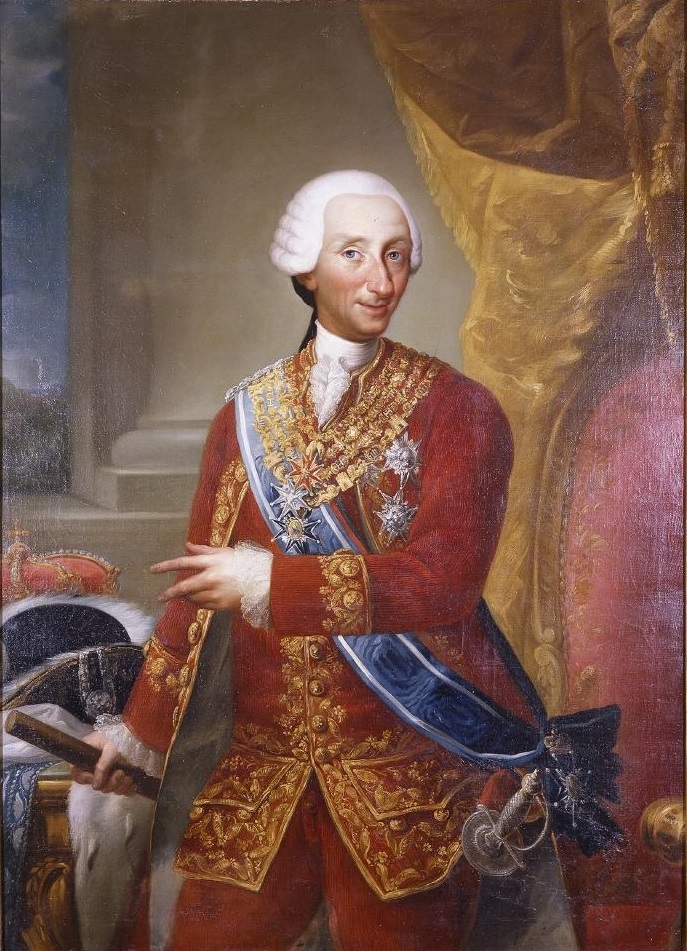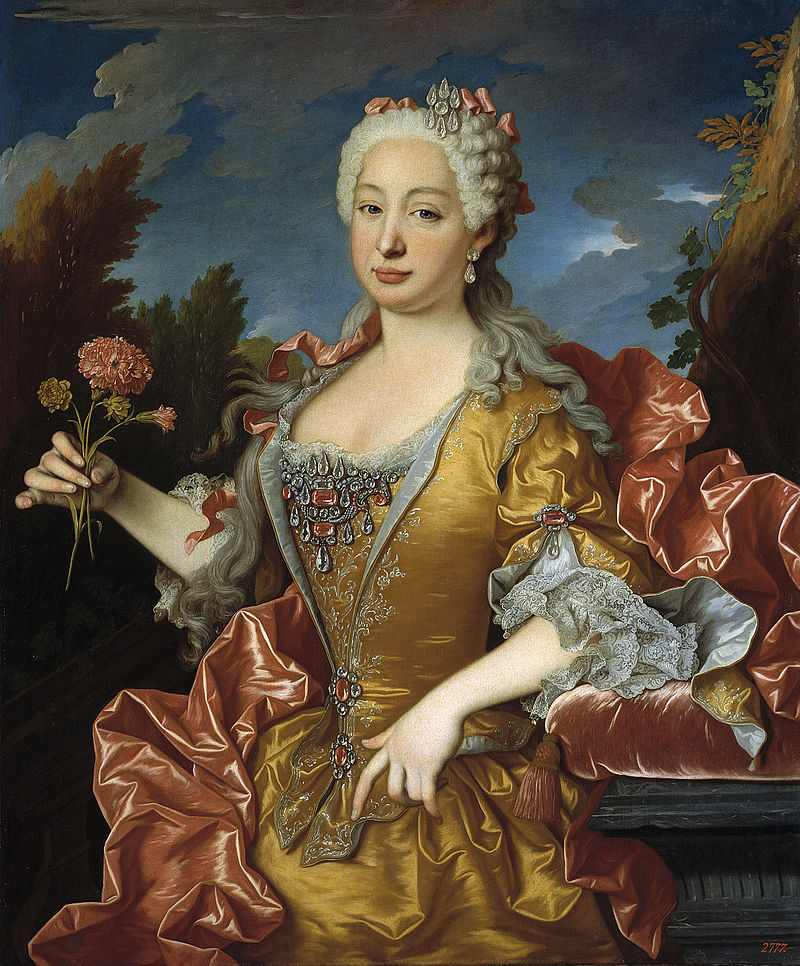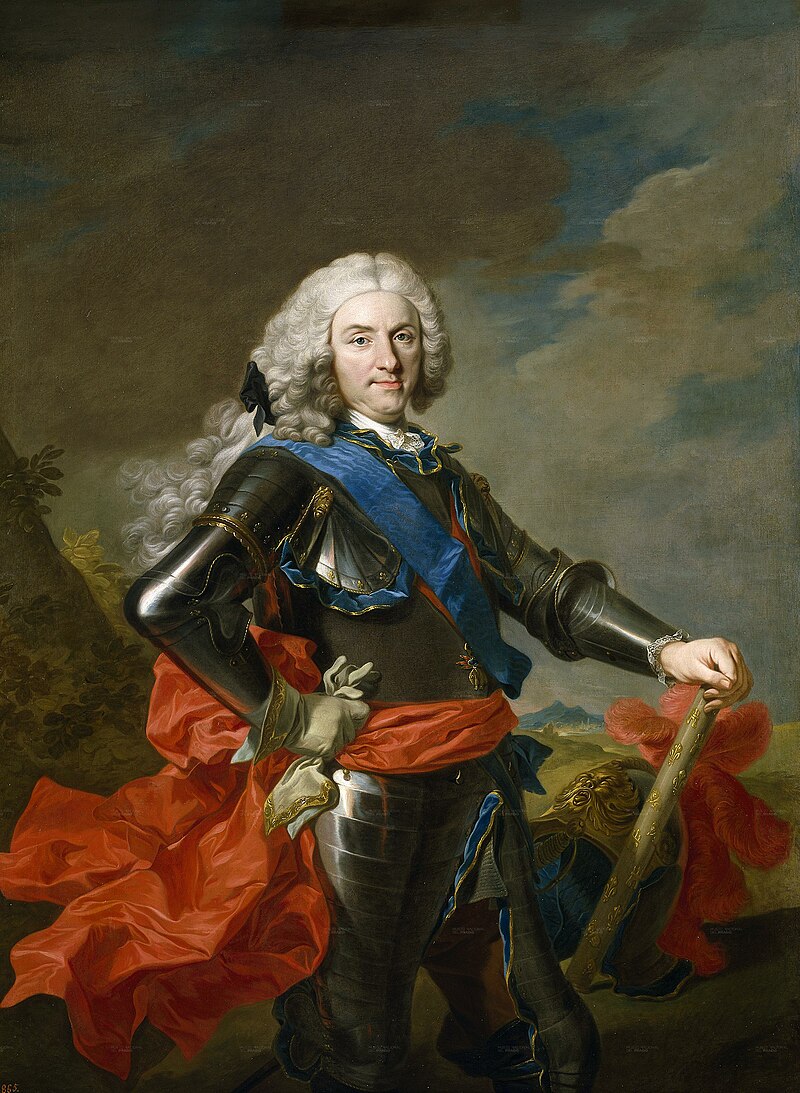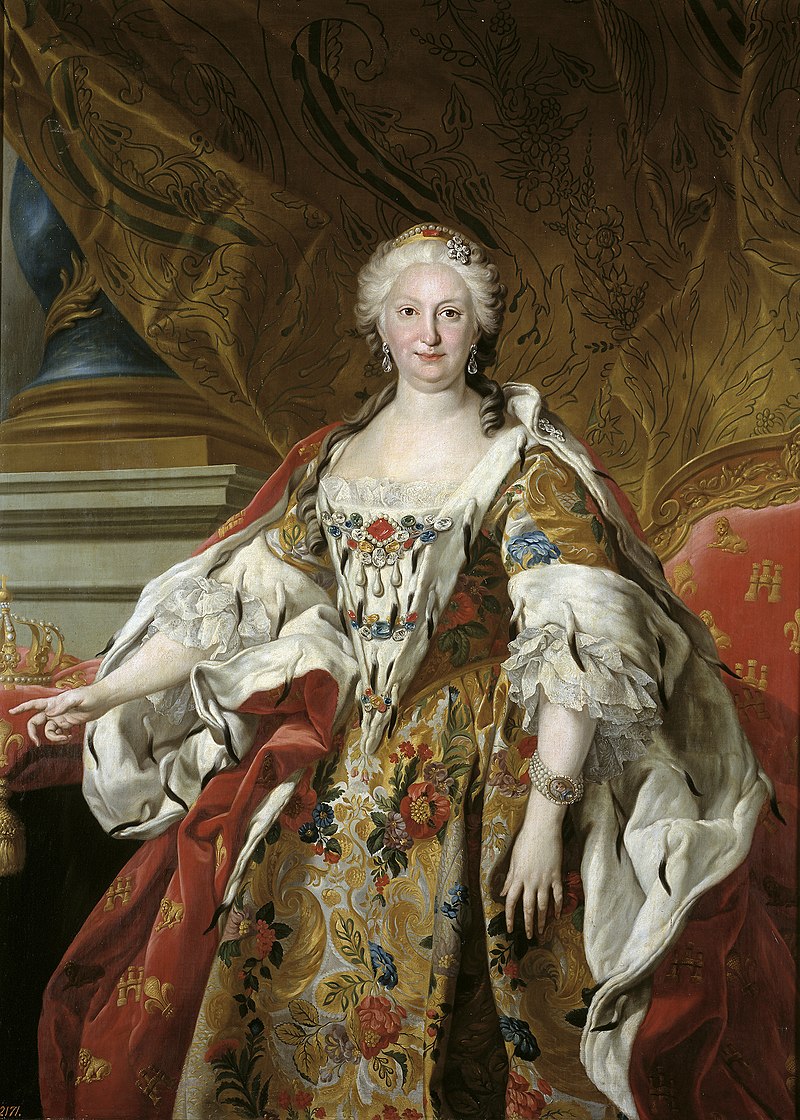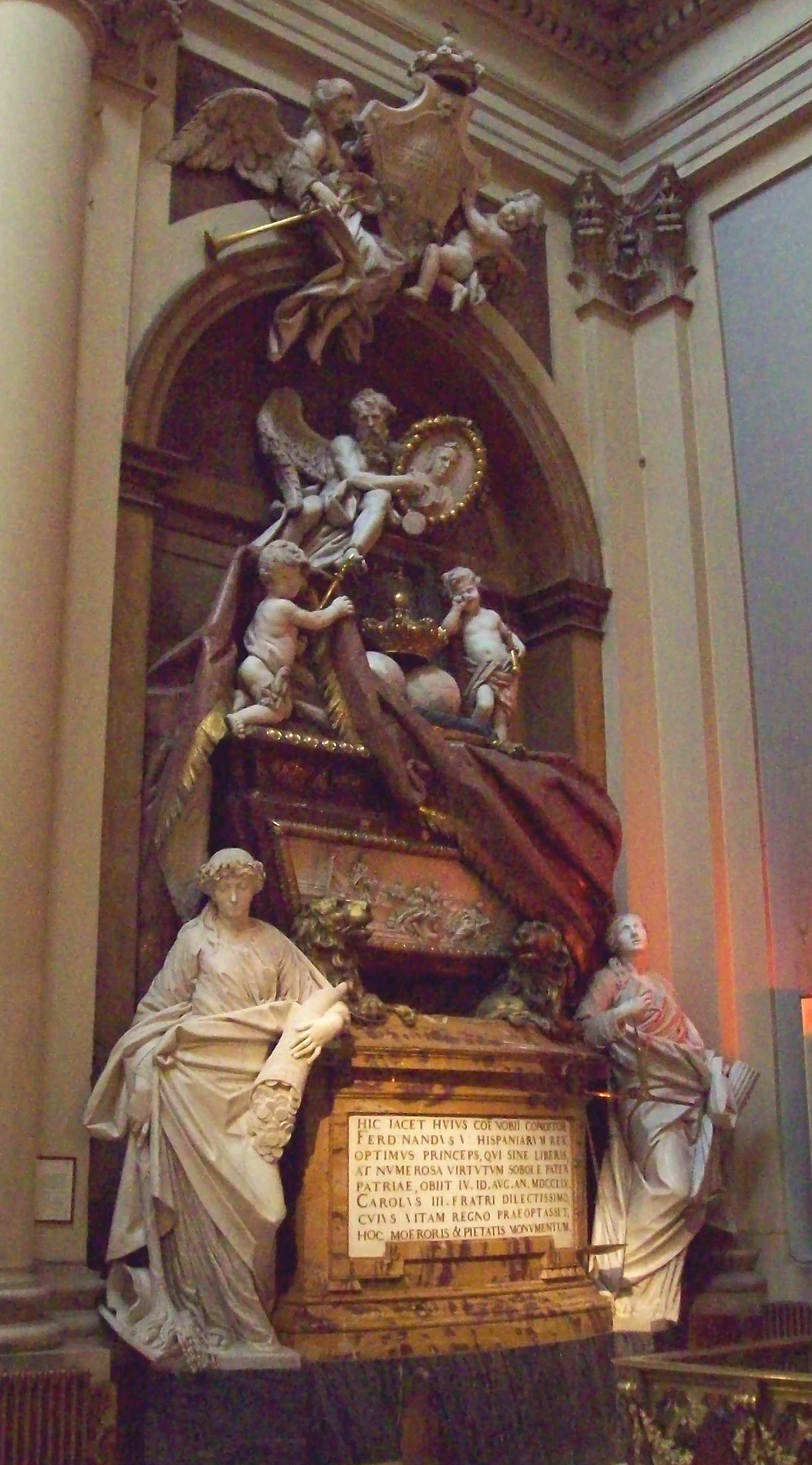by Susan Flantzer
© Unofficial Royalty 2023

Maria of Spain and Austria, Holy Roman Empress; Credit – Wikipedia
The Holy Roman Empire was a limited elective monarchy composed of hundreds of kingdoms, principalities, duchies, counties, prince-bishoprics, and Free Imperial Cities in central Europe. The Holy Roman Empire was not really holy since, after Holy Roman Emperor Charles V in 1530, no emperors were crowned by the pope or a bishop. It was not Roman but rather German because it was mainly in the regions of present-day Germany and Austria. It was an empire in name only – the territories it covered were mostly independent each with its own rulers. The Holy Roman Emperor directly ruled over only his family territories, and could not issue decrees and rule autonomously over the Holy Roman Empire. A Holy Roman Emperor was only as strong as his army and alliances, including marriage alliances, made him, and his power was severely restricted by the many sovereigns of the constituent monarchies of the Holy Roman Empire. From the 13th century, prince-electors, or electors for short, elected the Holy Roman Emperor from among the sovereigns of the constituent states.
Frequently but not always, it was common practice to elect the deceased Holy Roman Emperor’s heir. The Holy Roman Empire was an elective monarchy. No person had a legal right to the succession simply because he was related to the current Holy Roman Emperor. However, the Holy Roman Emperor could and often did, while still alive, have a relative (usually a son) elected to succeed him after his death. This elected heir apparent used the title King of the Romans.
- Learn more at Unofficial Royalty: What was the Holy Roman Empire?
********************

Maria’s powerful father Charles V, Holy Roman Emperor, King of Spain, Archduke of Austria, Lord of the Netherlands, Duke of Burgundy, among other titles; Credit – Wikipedia
Maria, Infanta of Spain, Archduchess of Austria was the wife of her first cousin Maximilian II, Holy Roman Emperor. Born on June 21, 1528, at the Royal Alcázar of Madrid, Kingdom of Spain, Maria was the second of the five children and the elder of the two daughters of Charles V, Holy Roman Emperor (also Carlos I, King of Spain; Karl I, Archduke of Austria; Charles II, Lord of the Netherlands, Duke of Burgundy, among many other titles) and Isabella of Portugal. Maria’s father was Charles was one of the most powerful ever monarchs and had a large number of titles due to his vast inheritance of the Burgundian, Spanish, and Austrian realms from his parents, Maria’s paternal grandparents, Philip of Austria, Duke of Burgundy, the ruler of the vast and wealthy Burgundian State, and Juana, Queen of Castile and León and Queen of Aragon The Kingdoms of Castile, León, and Aragon were combined into the Kingdom of Spain under Maria’s father. Maria’s maternal grandparents were Manuel I, King of Portugal and his second of three wives Maria of Aragon, her namesake.
Maria had four siblings but only two survived childhood:
- Felipe II, King of Spain (1527 – 1598), married (1) his double first cousin Maria Manuela, Infanta of Portugal who died giving birth to a son who predeceased his father (2) his first cousin once removed Queen Mary I of England, no children (3) Elisabeth of Valois, had five pregnancies but only two surviving daughters, Elisabeth died a few hours after the loss of her last child (4) his niece Anna of Austria had five children but only one son Felipe III, King of Spain survived childhood, Anna died of heart failure eight months after giving birth to her last child
- Ferdinand of Austria (1529 – 1530), died in infancy
- Juana of Austria (1535 – 1573), married her first cousin João Manuel, Hereditary Prince of Portugal, had one son Sebastian, King of Portugal
- Juan of Austria (1537 – 1538), died in infancy

Maria’s mother Isabella of Portugal; Credit – Wikipedia
The main residence of Maria’s parents Charles and Isabella was in Spain as the Spanish nobles had insisted that their children be raised in Spain. Charles was often away from his family to lead military campaigns and administer his other realms, and Isabella was appointed Regent of Spain in his absence. Isabella supervised her children’s education and taught them Portuguese. In 1539, when Maria was 11 years old, her mother Isabella developed a fever causing her to miscarry during the third month of her seventh pregnancy. The fever caused her condition to worsen and Isabella died two weeks later on May 1, 1539, aged thirty-five. Maria’s father Charles was so grief-stricken that he shut himself up in a monastery for two months where he prayed and mourned for Isabella in solitude. He never recovered from her death, dressed in black for the rest of his life, and despite being only thirty-nine, never remarried.

Maria’s husband Maximilian, circa 1544; Credit – Wikipedia
On September 13, 1548, Maria married her first cousin Archduke Maximilian of Austria (the future Holy Roman Emperor Maximilian II), the son of her paternal uncle Ferdinand I, Archduke of Austria (the future Holy Roman Emperor Ferdinand I) and Anna of Bohemia and Hungary. With this marriage, Maria’s father intended to strengthen the ties between the Austrian Habsburgs and the Spanish Habsburgs. While Maria’s father Holy Roman Emperor Charles V was occupied with the affairs of his other realms, Maria and Maximilian acted as regents of Spain from 1548 to 1551, during the absence of Maria’s brother, the future King Felipe II of Spain. In 1552, the couple moved to live at the court of Maximilian’s father in Vienna, Archduchy of Austria.

Maria and her husband Maximilian with their three eldest surviving children Anna, Rudolf, and Ernst; Credit – Wikipedia
Maximilian and Maria had fifteen children:
- Archduchess Anna of Austria, Queen of Spain (1549 – 1580), married her maternal uncle King Felipe II of Spain (his fourth wife), had five children but only one survived childhood
- Archduke Ferdinand of Austria (1551 – 1552), died in infancy
- Rudolf II, Holy Roman Emperor (1552 – 1612), unmarried
- Archduke Ernst of Austria, Governor of the Low Countries (1553 – 1595), unmarried
- Archduchess Elisabeth of Austria, Queen of France (1554 – 1592), married King Charles IX of France, had one daughter who did not survive childhood
- Archduchess Marie of Austria (1555 – 1556), died in infancy
- Matthias, Holy Roman Emperor (1557 – 1619), married Anna of Tyrol, no children
- Archduke Maximilian of Austria (1558 – 1618), unmarried
- Albrecht VII, Archduke of Austria, Governor of the Low Countries (1559 – 1621), married his first cousin Isabella Clara Eugenia of Spain, no surviving children
- Archduke Wenceslaus of Austria (1561 – 1578), unmarried, died in his teens
- Archduke Friedrich of Austria (1562 – 1563), died in infancy
- Archduchess Marie of Austria (born and died 1564), died a month after her birth
- Archduke Charles of Austria (1565 – 1566), died in infancy
- Archduchess Margaret of Austria (1567 – 1633), refused to marry her uncle King Felipe II of Spain whose fourth wife (Margaret’s eldest sister Anna) had died, became a nun under the name of Sister Margaret of the Cross at the Monastery of Santa Clara de las Descalzas Reales in Madrid, Spain
- Archduchess Eleanor of Austria (1568 – 1580), died in childhood
Physically exhausted after forty years of ruling, Maria’s father Charles abdicated in 1555 and retired to the peace of the Monastery of Yuste in Extremadura, Spain where he died in 1558. Upon Charles’s abdication, his younger brother, Ferdinand, the father of Maria’s husband, who had already been given Charles’ Austrian lands in 1521, became the Holy Roman Emperor. The Spanish Empire, including the possessions in the Netherlands, Italy, and the New World, was inherited by Charles’ son and Maria’s brother who reigned as Felipe II, King of Spain. In December 1562, Ferdinand had his eldest son and Maria’s husband Maximilian elected King of the Romans, meaning that he would become Maximilian II, Holy Roman Emperor. In addition, Ferdinand passed the crown of Hungary to his son in 1563. Plagued by fever attacks during the last years of his life, Ferdinand died in Vienna, Archduchy of Austria, now in Austria, on July 25, 1564, aged 61. Maria’s husband Maximilian was now Maximilian II, Holy Roman Emperor, King of Bohemia, King of Hungary and Croatia, and Archduke of Austria.

Maximilian II, Holy Roman Emperor, 1569; Credit – Wikipedia
During his reign, Maria’s husband Maximilian II had to deal with the effects of the 1555 Peace of Augsburg. The Peace of Augsburg officially ended the religious struggle between Lutherans and Catholics, and made the legal division of Christianity permanent within the Holy Roman Empire, allowing the rulers of the constituent kingdoms, principalities, duchies, counties, prince-bishoprics of the Holy Roman Empire to choose either Lutheranism or Roman Catholicism as the official religion of their state.
During her life in Austria as Holy Roman Empress, Maria, a devout Catholic, was ill at ease with the Lutheran religion and surrounded herself with a circle of devout Catholic courtiers, many of whom were from native Spain. Her court was organized by her Spanish chief lady-in-waiting Margarita Folc de Cardona i Requesens in a Spanish manner.
There has been much debate about the nature of the religious beliefs of Maria’s husband Maximilian. There was a pro-Protestant contingent among the nobility at the court in Vienna. Johann Sebastian Pfauser, Maximilian’s court chaplain, had originally been Roman Catholic but converted to Lutheranism. Through his influence, Maximilian abandoned purely Catholic customs, read Protestant literature, and refused to receive Communion according to the Catholic rite. He once told his father that worshiping saints was meaningless and idolatrous. Maria frequently disagreed with her religiously ambiguous husband about his religious tolerance. However, Maximilian remained Roman Catholic and never converted to Lutheranism.
In 1572, Maximilian II passed the crown of Hungary to his son Rudolf, and in 1575, Rudolf was also granted the crowns of Bohemia and the Habsburg hereditary territories. Rudolf was elected King of the Romans in 1575, ensuring that he would succeed his father as Holy Roman Emperor. Maximilian II, Holy Roman Emperor died, aged forty-nine, in the Imperial City of Regensburg, now in the German state of Bavaria, on October 12, 1576. On his deathbed, Maximilian refused to receive the Last Rites of the Roman Catholic Church.

Maria in retirement at the Monastery of Santa Clara de las Descalzas Reales in Madrid, Spain, 1600; Credit – Wikipedia
After Maximilian’s death, Maria remained in Vienna for six years and had great influence over her sons Rudolf and Matthias, both Holy Roman Emperors. She returned to Spain in 1582, rejoicing to live in “a country without heretics.” Maria retired to the Monastery of Santa Clara de las Descalzas Reales in Madrid, Spain, founded in 1559 by her younger sister Juana when she was left a young widow and where she lived until she died in 1573. This was the same convent where Maria’s daughter Margaret became a nun after refusing to marry her uncle King Felipe II of Spain after his fourth wife, Maria’s eldest daughter Anna, died. At the convent, Maria lived half as a nun in devout prayer, and half as a princess, still exerting influence on the Spanish court.

The Monastery of Santa Clara de las Descalzas Reales in Madrid, Spain where Maria lived the last years of her life, died, and was buried; Credit – By Luis García, CC BY-SA 3.0, https://commons.wikimedia.org/w/index.php?curid=7770261
In 1587, Maria’s brother King Felipe II of Spain sent Father Tomás Luis de Victoria, a Catholic priest and the most famous Spanish composer of the Renaissance, to the Monastery of Santa Clara de las Descalzas Reales as his sister’s chaplain. Father de Victoria remained at the convent for 24 years, serving as Maria’s chaplain until her death, and then as the convent organist. One of his most famous works is his Officium Defunctorum, a requiem mass composed for Maria’s funeral. On February 26, 1603, Maria died and was buried at the Monastery of Santa Clara de las Descalzas Reales in Madrid, Spain, aged seventy-four, having survived her husband by twenty-seven years.
This article is the intellectual property of Unofficial Royalty and is NOT TO BE COPIED, EDITED, OR POSTED IN ANY FORM ON ANOTHER WEBSITE under any circumstances. It is permissible to use a link that directs to Unofficial Royalty.
Works Cited
- Flantzer, Susan. (2022) Charles V, Holy Roman Emperor, King of Spain, Archduke of Austria, Lord of the Netherlands, Duke of Burgundy, Unofficial Royalty. Available at: https://www.unofficialroyalty.com/charles-v-holy-roman-emperor-carlos-i-king-of-spain-karl-i-archduke-of-austria-charles-ii-lord-of-the-netherlands-duke-of-burgundy/ (Accessed: 29 May 2023).
- Flantzer, S. (2022) Isabella of Portugal, Queen of Spain, Holy Roman Empress, Unofficial Royalty. Available at: https://www.unofficialroyalty.com/isabella-of-portugal-queen-of-spain-holy-roman-empress/ (Accessed: 29 May 2023).
- Flantzer, Susan. (2023) Maximilian II, Holy Roman Emperor, King of Bohemia, King of Hungary and Croatia, Archduke of Austria. Available at: https://www.unofficialroyalty.com/maximilian-ii-holy-roman-emperor-king-of-bohemia-king-of-hungary-and-croatia-archduke-of-austria/ (Accessed: 29 May 2023).
- Maria of Austria, Holy Roman Empress (2023) Wikipedia. Available at: https://en.wikipedia.org/wiki/Maria_of_Austria,_Holy_Roman_Empress (Accessed: 29 May 2023).
- Maria von Spanien (1528–1603) (2021) Wikipedia (German). Available at: https://de.wikipedia.org/wiki/Maria_von_Spanien_%281528%E2%80%931603%29 (Accessed: 29 May 2023).
- Wheatcroft, Andrew, 1995. The Habsburgs. London: Viking.
- Wilson, Peter, 2016. Heart of Europe: A History of the Holy Roman Empire. Cambridge: Harvard University Press.

































